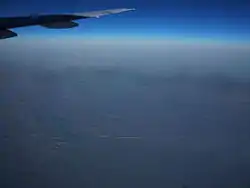Kanchalan (river)
The Kanchalan (Russian: Канчалан) is a river in the Russian Far East. It passes through the sparsely populated areas of the Anadyr Lowlands and flows southwards into the Bering Sea at the Gulf of Anadyr through the Anadyrsky Liman. It is 426 kilometres (265 mi) long, and has a drainage basin of 20,600 square kilometres (8,000 sq mi).[1]
| Kanchalan | |
|---|---|
 The Kanchalan estuary (center left) opening into the Anadyrsky Liman | |
| Location | |
| Country | Russia |
| Physical characteristics | |
| Mouth | Bering Sea |
• location | Gulf of Anadyr |
• coordinates | 65.0573°N 176.4191°E |
| Length | 426 km (265 mi) |
| Basin size | 20,600 km2 (8,000 sq mi) |
History
The Kanchalan and its tributaries belong to the Chukotka Autonomous Okrug administrative region of Russia. There is a small populated place in the area close to its estuary also called Kanchalan.[2] Originally the river appears to have been called the Nyerpicha according to maps of the 17th and 18th centuries.[2] A sedentary people who went on to form the eponymous settlement lived on its banks who called themselves "Konchalyt", (from the Chukchi кончальыт meaning Only[2]) and over time their name became associated with both the settlement and the river itself.[2] In Chukchi, the river is divided into two parts, the lower reaches are called Gytgomkyvaam (Гытгомкываам, lit. Bush River),[2] whilst the upper reaches are called Tadlyeoan (Тадлеоан, lit. The Place of Vengeance) as this was the site of historical battles between the Chukchi, Yukaghirs and Koryaks.[2]
Wildlife
Beluga whales are common in its estuarine waters.
References
- Река Канчалан (в верховье Южн. Тадлеоан) in the State Water Register of Russia (Russian)
- Kanchalan - Electoral Commission of Chukotka Autonomous Okrug
External links
- Litovka, D. I. (2002). "Beluga distribution". Russian Journal of Marine Biology. 28 (4): 263–266. doi:10.1023/A:1020277211821. S2CID 1381536.
- Bird life
- Makoedov, A. N.; Korotaev, Yu. A.; Korotaeva, O. B. (2001). "Chum salmon in the Kanchalan River". Russian Journal of Marine Biology. 27 (4): 238–244. doi:10.1023/A:1011915419911. S2CID 29355676.